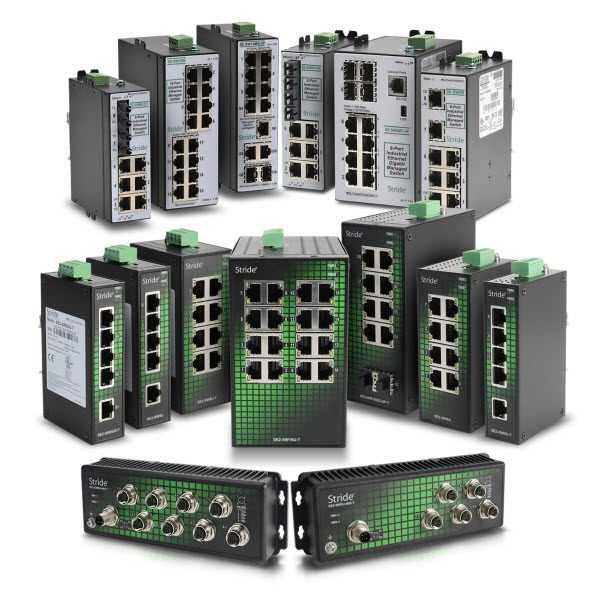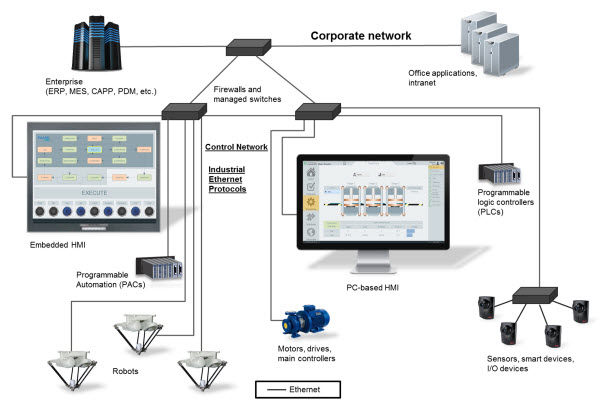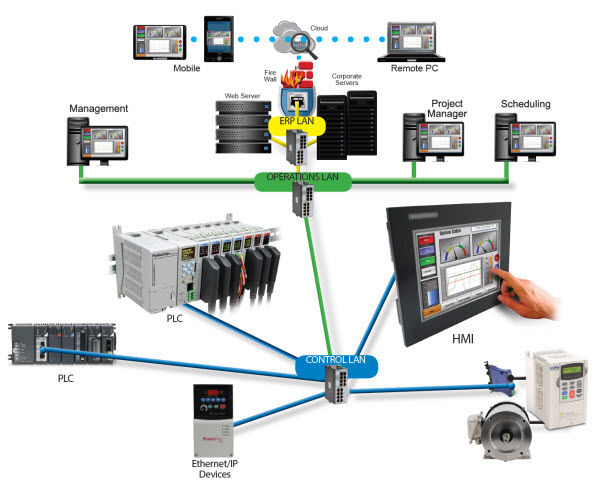Deterministic Ethernet and Time Sensitive Network (TSN) are current industrial automation buzzwords—both related to how control data and information can flow through network pipes. A little history and understanding of industrial fieldbus communications will help explain where we are now and where we’re going with deterministic Ethernet and TSN.
The history starts decades ago when the fieldbus’ physical network wasn’t Ethernet. Some will call it a serial bus, but at the control and field level, it was dedicated I/O communication networks such as DeviceNet and Profibus; drive networks like Sercos; and safety communication networks such as Safetybus-p. In terms of controller-to-controller and controller-to-HMI communication, networks were mostly proprietary to each vendor.
Ethernet was just used to connect to upper level MES, ERP and SCADA systems because it wasn’t deemed ready for more critical control system communications.
Click the image to enlarge or click here.
The rise of Ethernet in industrial automation was fueled by the IEEE 802 local area network (LAN) standards, created back in the 80’s and continuously revised since then. Many current networks were designed using the Purdue computer integrated manufacturing model of control hierarchy that rigidly defined the levels in a factory from the plant floor to enterprise level systems.
These levels include field devices, machine cells and areas, operations, management and services, and enterprise zones. The enterprise at level 5 must traverse five levels to access data from a robot sensor at level 0 on the plant floor.
The Purdue computer integrated manufacturing model is well designed, but existing network infrastructures based on it are not well designed to transmit the time-sensitive data needed for real-time control. TSN addresses this issue, but let’s talk about deterministic Ethernet first.
It Has Been Determined
Deterministic Ethernet can be in the eye of the beholder, but requires an industrial Ethernet-based protocol. An example is Modbus RTU, an open RS-232 or RS-485 serial protocol with a master/slave architecture. It’s a serial system deterministic enough for building management and other slow moving systems, but not for real-time control of fast-acting machines.
But faster is better, and deterministic Ethernet exists now in many forms, with nondeterministic Ethernet a thing of the past, a term from decades ago when half-duplex, 10Base-2 coax-cable Ethernet was used. Today, CAT5e cables and industrial Ethernet switches provide a physical layer capable of supporting a fast, deterministic network for controller-to-controller, controller-to-HMI, and HMI-to-Enterprise connections. Those who say the network is nondeterministic should know that technology has left them behind, as have the fieldbus protocols running on an Ethernet network.

For controller-to-I/O and other control applications, deterministic, Ethernet-based, real-time control fieldbus protocols have made the nondeterminism of Ethernet a thing of the past. Since the early 2000s, Ethernet and its high bandwidth of 100 Mbit/s has been used for I/O, motion and safety real-time control. Even standard Modbus TCP is approaching deterministic speeds with 10 ms response times possible.
It is important to understand that the Transmission Control Protocol (TCP) part of the TCP/IP protocol of the Internet is, in fact, nondeterministic. However, Ethernet-based fieldbus protocols don’t use nondeterministic TCP. User datagram protocol (UDP) is used instead, along with Internet protocol (IP) addressing.
EtherNet/IP protocol is a very popular Ethernet-based control fieldbus, and it is controlling machines, I/O, drives and many other smart devices at millisecond update rates all over the world. Profinet and PowerLink are two other real-time (deterministic) industrial Ethernet protocols. EtherCAT, Profinet IRT and Sercos III control fieldbuses are even faster, but need special hardware to achieve their sub-microsecond speeds. Checkout the IEC 61158-1:2014 standard for more info.
While these real-time Ethernet protocols can all run on the same wire, they often cannot co-exist on the same physical network. Data packet collisions are not allowed by a protocol, but this can happen if Ethernet-based fieldbuses are mixed on the same network. This is often the case in large industrial control systems and will slow communications, so I/O, robots, safety and HMI/SCADA systems should have their own separate network. Real-time Ethernet protocols need network exclusivity right now, but Ethernet TSN will address this issue.
Click the image to enlarge or click here.
TSN Flattens the Network
An experienced industrial automation network expert can create deterministic Ethernet networks now, but Ethernet TSN will make it easier by adding a fast lane to the network. Ethernet TSN is just getting started as a standard, and expectations are high. It’s expected to make it easier to consolidate systems, such as multiple machine controllers and devices, into a larger and faster local network.
Instead of several, unconnected control networks—all the networks will be tied together and connected to the enterprise, fulfilling the promise of the IIoT. Ethernet TSN will connect a lot more devices and machines, providing access to control loops and data.
Ethernet TSN will make Ethernet, by itself and without a fieldbus protocol, deterministic. It’s the final piece of the puzzle that will finally bring IT and OT networks together, and it will do this by flattening the network. Different Ethernet protocols will share the same network infrastructure. It looks like no Ethernet gateways will be need, only Ethernet switches. This will help designers create a fast and secure Ethernet connection from the smart sensor to the enterprise system and the cloud.
These are real Ethernet TSN features and they are being defined in the latest version of the IEEE 802 network standard. This standard has been built upon and improved for the last three decades, and this will continue with TSN.
For more information, checkout the How time-sensitive networking enables the IIoT article on the Control Design website.




